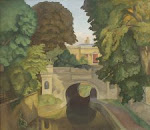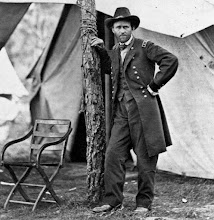Yesterday, I noticed a single purple and yellow flower beside a driveway. It seemed pansy-like. Might it have been heartsease? I'd be the last to know.
David Chatterton (1900-1963), "Vase with Yellow Chrysanthemums"
"Balm in Gilead"
Heartsease I found, where Love-lies-bleeding
Empurpled all the ground:
Whatever flowers I missed unheeding,
Heartsease I found.
Yet still my garden mound
Stood sore in need of watering, weeding,
And binding growths unbound.
Ah, when shades fell to light succeeding
I scarcely dared look round:
"Love-lies-bleeding" was all my pleading,
Heartsease I found.
Christina Rossetti, Verses (1893).
This is one of those poems by Rossetti that might be a religious poem (as suggested by the title), but might well be a tale of romantic heartbreak. But I shouldn't sell her short: it is entirely possible that it is both.
Charles Ginner, "Dahlias and Cornflowers" (1929)
According to the OED, "heart's ease" is "peace of mind; freedom from care or worry; contentment." A thing rarely happened upon?
The Heartsease
Do you remember that hour
In a nook of the flowing uplands
When you found for me, at the cornfield's edge,
A golden and purple flower?
Heartsease, you said. I thought it might be
A token that love meant well by you and me.
I shall not find it again
With you no more to guide me.
I could not bear to find it now
With anyone else beside me.
And the heartsease is far less rare
Than what it is named for, what I can feel nowhere.
Once again it is summer:
Wildflowers beflag the lane
That takes me away from our golden uplands,
Heart-wrung and alone.
The best I can look for, by vale or hill,
A herb they tell me is common enough -- self-heal.
C. Day Lewis, Poems 1943-1947 (1948).
Adam Bruce Thomson, "Still Life at a Window" (c. 1944)






4 comments:
Mr Pentz, thank you for these two poems, both new to me. I particularly like the C Day Lewis.
Like yourself I am not especially good at identifying flowers, a small number I know quite well, the vast majority lie outside my sphere of knowledge,but as you say sometimes "looking is sufficient". Thanks again.
Mr Ashton: I'm pleased that you enjoyed the poems.
As I think we have discussed before, due to her large number of poems, reading Rossetti is like reading Hardy: new and unexpected poems are always coming to light, and, in addition, you come across fine poems that you have read, but have nearly forgotten. I have been trying to become better acquainted with C. Day Lewis's poems this year. I confess that his politically-tinged poems of the 30s and early 40s are not of interest to me, but I have been discovering a number of fine poems in the years after that.
It's always good to hear from you. Thank you for stopping by.
Stephen, I cannot stop myself from pontificating ever so briefly about flower names.. Heart's ease, sometimes called Viola Tricolor is in the viola family and so called because it cannot help but ease a troubled heart when one looks upon it. Truly, the country names for flowers are so much more endearing and full of truth and lore than the Latin names. Cases in point, Jack in the Pulpit, Ox Eye Daisy and Adder's tongue.
Julie
Julie: I agree completely. The Latin names are of no interest to me, but I love the popular names. I note, for instance, that heartsease is also called "love-in-idleness." Now where does that come from? I know that there are books out there that explain the origins of these lovely names, and I need to track one down to educate myself.
It's very nice to hear from you again. I hope that all is well.
Post a Comment